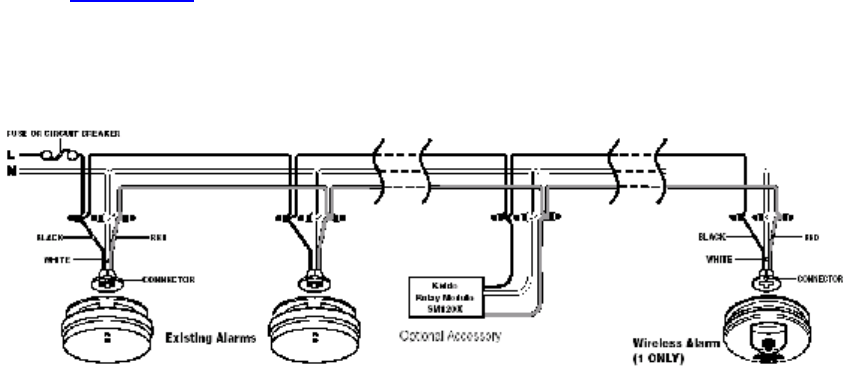User's Manual

WIRING INSTRUCTIONS FOR A.C. QUICK CONNECT HARNESS
CAUTION! TURN OFF THE MAIN POWER TO THE CIRCUIT BEFORE WIRING THE ALARM.
• If you are using the Kidde ACDC Wireless alarms to replace Hardwired alarms that are not interconnected (see definitions on
Quick Setup Guide), DO NOT CONNECT THE RED WIRE TO ANYTHING. Leave the red wire-insulating cap in place to
make certain that the red wire cannot contact any metal parts or the electrical box.
• When alarms are interconnected, all interconnected units must be powered from a single circuit.
• Only one WIRELESS ACDC alarm may be used when all existing alarms are Hardwired with Interconnect (see definitions on
Quick Setup Guide).
• A maximum of 24 devices may be Hardwire Interconnected in a multiple station arrangement. The interconnect system should
not exceed the NFPA interconnect limit of 12 smoke alarms and/or 18 alarms total (smoke, heat, carbon monoxide, etc.). With
18 alarms interconnected, it is still possible to interconnect up to a total of 6 remote signaling devices and/or relay modules.
Kidde alarms and accessories CAN ONLY BE interconnected with other Kidde alarms and accessories as well as
specified brands and models of interconnect compatible alarms. Connection of Kidde products to a non-
specified manufacturer’s interconnect system, or connection with non-specified equipment from another
manufacturer into an existing Kidde system could result in nuisance alarming, failure to alarm, or damage to one
or all of the devices in the interconnect system. Refer to User’s Guide supplied with each Kidde product for lists
of interconnect compatible models, brands, and devices
• When mixing models that have battery backup (1275, 1276, 1285, 1296, PE120, PI2000, KN-COSM-IB, hd135F,
KN-COB-IC, KN-COP-IC) with models without battery backup (1235, KN-COSM-I, 120X, SM120X, CO120X, SL177i), be
advised that the models without battery backup will not respond during an AC power failure.
• For more information about compatible interconnect units and their functionality in an interconnect system, visit our web site
at: www.KiddeUS.com.
• The maximum wire run distance between the first and last unit in an interconnected system is 1000 feet.
• Figure 1 illustrates interconnection wiring. Improper connection will result in damage to the alarm, failure to operate, or a
shock hazard.
• Make certain alarms are wired to a continuous (non-switched) power line. NOTE: Use standard UL listed household wire (18
gauge or larger as required by local codes) available at all electrical supply stores and most hardware stores.
Figure 5
INTERCONNECT WIRING DIAGRAM
WIRES ON ALARM HARNESS CONNECTED TO:
Black Hot Side of A.C. Line
White Neutral Side of A.C. Line
Red Interconnect Lines (Red Wires) of Other Units in the Multiple Station Setup
BATTERY INSTALLATION
CAUTION! THIS UNIT WILL NOT FUNCTION WITHOUT A PROPERLY INSTALLED BATTERY, AND IS EQUIPPED
WITH A BATTERY LOCKOUT FEATURE WHICH PREVENTS THE BATTERY DOOR
FROM CLOSING IF A BATTERY IS NOT INSTALLED CORRECTLY.
If your unit was supplied with a yellow pull tab, gently pull the tab out to activate the battery backup once the unit has been connected
to AC power and mount to the electrical box with the included trim ring. See MOUNTING INSTRUCTIONS in the following section.
To install a battery for the first time remove the alarm from the mounting bracket and open the battery door. Battery installation
instructions are provided on the inside of the battery door. When installing the battery, press the battery reminder finger down into the
battery compartment and install the battery (see Figure 6).
.










